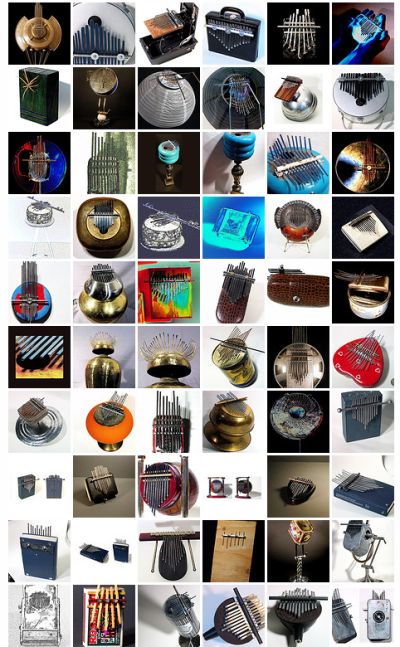Sometimes an instrument you know can become something else altogether. Bob Collier has been constructing his own thumb pianos, adding amplification, effects, self-sampling features, and novel cases involving recycled camera bodies and faux fur. As Bob says, “Sometimes the crudest and roughest looking kalimbas can sound surprisingly good especially with the right context of fx and
amplification.”
I find kalimbas beautiful and delicate to begin with. Throw in some faux fur and Korg KAOSS Pad effects, and they take on a whole new life:
Other designs add all-new functionality, like the Sampimer, a “self-sampling” thumb piano with integrated 20-second voice recorder, a speaker covered by a lens cap, and a body made out of a jewelry caddy:

I asked Bob a bit more about the designs, and out came still more ingenious re-adaptations of the lowly kalimba. He explains how he got started with this series in the first place:
Partly it flowed from an interest in making found object assemblage sculpture. I had owned and played kalimbas, I had made stringed instruments and percussion instruments. After I eventually made my own thumb piano, I found that a lot of the found object materials I encountered lent themselves most readily to an exploration of the thumb piano concept.
… There is an interplay between “what will this sound like?” and “what will this look like?” The shape of a component — like
soundboard or resonator — can limit how the instrument is held and played, and this can influence the optimal tuning.
At a basic level it is about vibrating materials and how applied structures affect the sound. When you add audio fx into the equation, the thumb piano can be viewed as a controller for percussive effects. I see people using their Blackberry’s or text messaging on their cell phones and it looks like they are playing a thumb piano. Someone with the skills should design a MIDI version. There is something about the responsiveness of a vibrating tine that seems to have a great deal of potential.[The inspiration from] … cell phones is not only about the use of thumbs to run a controller, but also the idea of a portable pocket size interface.
So far the most functional integrated unit I’ve made is the camera piano:
Fits in the pocket and the tuning is protected.
This one is near the limit of playability, requiring a backing board to be able to play:
This is the smallest with an internal 1/8″ jack:
Anything smaller or thinner would need an external bracket to mount a 1/8″ jack. Another direction related to this is “what is the smallest size kalimba that retains playability with an externally mounted 1/4″ jack?”
Along with exploring the limits of size (scalability?), there is also a give and take between minimalism and complexity. This is an example of a lamellaphone that technically uses no hardware (such as machine screws etc.):
The parts of the unit are all held in place by a large magnet, making things easily adjustable.
Bob also sends along a prototype of the amberCan, which integrates an amp and speaker:

Via the Flickr description:
…in this instance with a Smokey Amp and added rheostat. The Smokey amp has no output control so the rheostat was added to provide volume control.
At low volume the instrument sounds normally electrified but at mid and hi volume the thumb piano becomes a feedback unit as the vibrations of the speaker are cycled into the piezo. Interestingly, at that point the pitch and tone can be altered by gently applying and varying finger pressure on the tines and lid rather than plucking.
For more on that instrument:
amerpCan shot
Exterior shot showing base and lid
Interior shot showing innards
And to hear what all of these instruments sound like, there’s a whole set of recorded tracks:
RP Collier Thumb Piano Project [SoundClick MP3s/streams]
Thanks for these gorgeous designs and insight into instrument-building, Bob. (All photos come by way of his seemingly-endless Flickr photo set of kalimbas, where you’ll find many more designs.)

Thumb piano set @ Flickr, with lots o’ links and more videos, etc.
I’m curious if any one else has approached kalimba amplification or construction, though it would be tough to top these. One tutorial on making thumb pianos:
instructables: Thumb Piano, via MAKE:Blog



